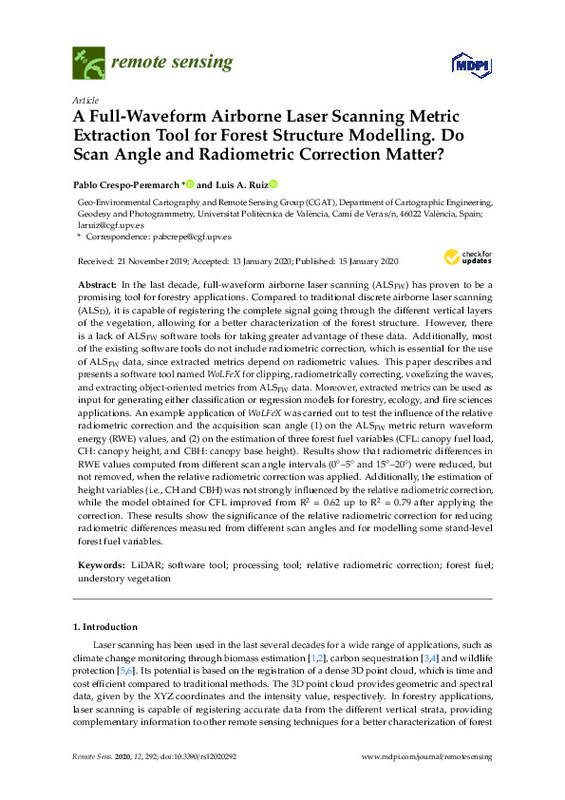JavaScript is disabled for your browser. Some features of this site may not work without it.
Buscar en RiuNet
Listar
Mi cuenta
Estadísticas
Ayuda RiuNet
Admin. UPV
A full-waveform airborne laser scanning metric extraction tool for forest structure modelling. Do scan angle and radiometric correction matter?
Mostrar el registro sencillo del ítem
Ficheros en el ítem
| dc.contributor.author | Crespo-Peremarch, Pablo
|
es_ES |
| dc.contributor.author | Ruiz Fernández, Luis Ángel
|
es_ES |
| dc.date.accessioned | 2021-11-05T14:06:34Z | |
| dc.date.available | 2021-11-05T14:06:34Z | |
| dc.date.issued | 2020-01 | es_ES |
| dc.identifier.issn | 2072-4292 | es_ES |
| dc.identifier.uri | http://hdl.handle.net/10251/176245 | |
| dc.description.abstract | [EN] In the last decade, full-waveform airborne laser scanning (ALSFW) has proven to be a promising tool for forestry applications. Compared to traditional discrete airborne laser scanning (ALSD), it is capable of registering the complete signal going through the different vertical layers of the vegetation, allowing for a better characterization of the forest structure. However, there is a lack of ALSFW software tools for taking greater advantage of these data. Additionally, most of the existing software tools do not include radiometric correction, which is essential for the use of ALSFW data, since extracted metrics depend on radiometric values. This paper describes and presents a software tool named WoLFeX for clipping, radiometrically correcting, voxelizing the waves, and extracting object-oriented metrics from ALSFW data. Moreover, extracted metrics can be used as input for generating either classification or regression models for forestry, ecology, and fire sciences applications. An example application of WoLFeX was carried out to test the influence of the relative radiometric correction and the acquisition scan angle (1) on the ALSFW metric return waveform energy (RWE) values, and (2) on the estimation of three forest fuel variables (CFL: canopy fuel load, CH: canopy height, and CBH: canopy base height). Results show that radiometric differences in RWE values computed from different scan angle intervals (0°¿5° and 15°¿20°) were reduced, but not removed, when the relative radiometric correction was applied. Additionally, the estimation of height variables (i.e., CH and CBH) was not strongly influenced by the relative radiometric correction, while the model obtained for CFL improved from R2 = 0.62 up to R2 = 0.79 after applying the correction. These results show the significance of the relative radiometric correction for reducing radiometric differences measured from different scan angles and for modelling some stand-level forest fuel variables. | es_ES |
| dc.description.sponsorship | This research was funded by the Spanish Ministerio de Economia y Competitividad and FEDER, in the framework of the projects ForeStructure (CGL2013-46387-C2-1-R) and FIRMACARTO (CGL2016-80705-R). | es_ES |
| dc.language | Inglés | es_ES |
| dc.publisher | MDPI AG | es_ES |
| dc.relation.ispartof | Remote Sensing | es_ES |
| dc.rights | Reconocimiento (by) | es_ES |
| dc.subject | LiDAR | es_ES |
| dc.subject | Software tool | es_ES |
| dc.subject | Processing tool | es_ES |
| dc.subject | Relative radiometric correction | es_ES |
| dc.subject | Forest fuel | es_ES |
| dc.subject | Understory vegetation | es_ES |
| dc.subject.classification | INGENIERIA CARTOGRAFICA, GEODESIA Y FOTOGRAMETRIA | es_ES |
| dc.title | A full-waveform airborne laser scanning metric extraction tool for forest structure modelling. Do scan angle and radiometric correction matter? | es_ES |
| dc.type | Artículo | es_ES |
| dc.identifier.doi | 10.3390/rs12020292 | es_ES |
| dc.relation.projectID | info:eu-repo/grantAgreement/MINECO//CGL2013-46387-C2-1-R/ES/INTEGRACION DE TECNICAS AVANZADAS DE LIDAR Y METODOS PARA LA MODELIZACION Y CARTOGRAFIADO DE PARAMETROS DE COMBUSTIBILIDAD EN BOSQUES MEDITERRANEOS/ | es_ES |
| dc.relation.projectID | info:eu-repo/grantAgreement/AGENCIA ESTATAL DE INVESTIGACION//CGL2016-80705-R//ANALISIS Y VALIDACION DE PARAMETROS DE ESTRUCTURA FORESTAL DERIVADOS DE LIDAR Y OTRAS TECNICAS EMERGENTES Y SU INCIDENCIA EN LA MODELIZACION DEL POTENCIAL COMBUSTIBLE/ | es_ES |
| dc.rights.accessRights | Abierto | es_ES |
| dc.contributor.affiliation | Universitat Politècnica de València. Departamento de Ingeniería Cartográfica Geodesia y Fotogrametría - Departament d'Enginyeria Cartogràfica, Geodèsia i Fotogrametria | es_ES |
| dc.description.bibliographicCitation | Crespo-Peremarch, P.; Ruiz Fernández, LÁ. (2020). A full-waveform airborne laser scanning metric extraction tool for forest structure modelling. Do scan angle and radiometric correction matter?. Remote Sensing. 12(2):1-17. https://doi.org/10.3390/rs12020292 | es_ES |
| dc.description.accrualMethod | S | es_ES |
| dc.relation.publisherversion | https://doi.org/10.3390/rs12020292 | es_ES |
| dc.description.upvformatpinicio | 1 | es_ES |
| dc.description.upvformatpfin | 17 | es_ES |
| dc.type.version | info:eu-repo/semantics/publishedVersion | es_ES |
| dc.description.volume | 12 | es_ES |
| dc.description.issue | 2 | es_ES |
| dc.relation.pasarela | S\401068 | es_ES |
| dc.contributor.funder | AGENCIA ESTATAL DE INVESTIGACION | es_ES |
| dc.contributor.funder | MINISTERIO DE ECONOMIA Y EMPRESA | es_ES |








